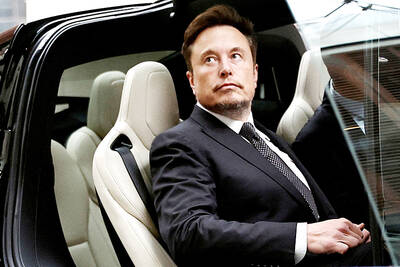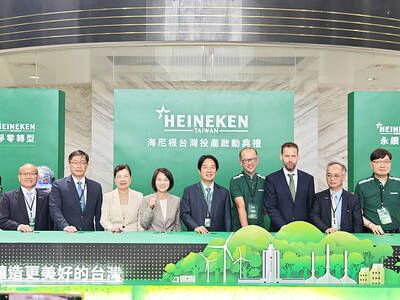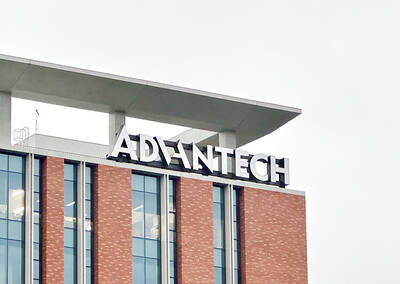Drug giant Pfizer says it will not split into two publicly traded companies, despite pressure from investors frustrated by its lagging stock price, ending years of Wall Street speculation over its strategy and future.
The biggest US-based drugmaker on Monday said that it believes it is best positioned to maximize shareholder value in its current form, but it reserves the right to split if the situation changes.
For several years, the maker of Viagra and pain treatment Lyrica has been under pressure from analysts and investors who argued that by splitting up, the resulting two companies might grow faster than one.

Photo: Bloomberg
As a result, Pfizer has been reporting detailed financial results for each of its business segments, information that would be required by regulators for a split.
Earlier this year, Pfizer promised a decision by the end of the year, but then it reorganized and renamed those segments — a sign a breakup was less likely.
Chances of the breakup began to fade even more over the summer, due in part to increasing sales for key new drugs from Pfizer and rising prospects for its drugs under development.
Pfizer CEO Ian Read told analysts last month that the prospect of a split was not a “make-or-break decision” for the company.
The firm recently said it had spent US$600 million on preparations for such a split.
“Given that Pfizer has been talking down expectations for a separation in recent months, we think the stock will only be down modestly on this news,” Jeffries analyst Jeffrey Holford wrote to investors.
Pfizer said that a split would not help the competitive positioning of its businesses and such a move would create disruptions and increased costs.
The drugmaker’s most likely path forward involves hunting for more acquisition targets, said Bernstein analyst Tim Anderson, who had pressed Pfizer repeatedly on its quarterly results conference calls to break up.
Pfizer has been buying several companies and products to help make up for a wave of sales losses to cheaper, generic competition, most notably for the cholesterol pill Lipitor.
It also attempted and failed at two mega-acquisitions, of Britain’s AstraZeneca PLC in 2014 and this year of Ireland’s Allergan PLC.
Both those deals had been structured as tax inversions, meant to allow Pfizer to move its headquarters from New York — but just on paper — to a country with lower tax rates to reduce its US tax bill.
AstraZeneca rebuffed Pfizer and the US Treasury Department set up new rules that effectively blocked the Allergan acquisition.
Last month, Pfizer said it would spend about US$14 billion to buy cancer drug developer Medivation and it is buying rights to AstraZeneca’s portfolio of approved and experimental antibiotic and antifungal pills.
In June, Pfizer completed a US$5.2-billion acquisition of Anacor Pharmaceuticals Inc, which could get a new eczema drug, Crisaborole, approved by January next year.
“A critic could argue that Pfizer is back to being the same old Pfizer as before, relying on [mergers and acquisitions] to grow and to refill its pipeline, but at the expense of growing larger in the process depending on the size of deals it chases,” Anderson said in a research note.

purpose: Tesla’s CEO sought to meet senior Chinese officials to discuss the rollout of its ‘full self-driving’ software in China and approval to transfer data they had collected Tesla Inc CEO Elon Musk arrived in Beijing yesterday on an unannounced visit, where he is expected to meet senior officials to discuss the rollout of "full self-driving" (FSD) software and permission to transfer data overseas, according to a person with knowledge of the matter. Chinese state media reported that he met Premier Li Qiang (李強) in Beijing, during which Li told Musk that Tesla's development in China could be regarded as a successful example of US-China economic and trade cooperation. Musk confirmed his meeting with the premier yesterday with a post on social media platform X. "Honored to meet with Premier Li

Dutch brewing company Heineken NV on Friday announced an investment of NT$13.5 billion (US$414.62 million) over the next five years in Taiwan. The first multinational brewing company to operate in Taiwan, Heineken made the statement at a ceremony held at its brewery in Pingtung County. It also outlined its efforts to make the brewery “net zero” by 2030. Heineken has been in the Taiwanese market for 20 years, Heineken Taiwan managing director Jeff Wu (吳建甫) said. With strong support from local consumers, the Dutch brewery decided to transition from sales to manufacturing in the country, Wu said. Heineken assumed majority ownership and management rights

coverage expansion: The industrial PC maker has proposed to acquire 3.938 million Aures shares to strengthen its global smart retail presence Leading industrial PC maker Advantech Co (研華) plans to acquire Aures Technologies SA, a French company known for its point-of-sale (POS) and kiosk equipment, to expand its global coverage in smart retail products and services. Advantech proposed to acquire 3.938 million Aures shares from the French firm’s major shareholder and through a public tender offer at up to 6.7 euros per share, the PC maker said in a statement after announcing the deal at the Taiwan Stock Exchange late on Friday. The company aims to acquire up to 100 percent equity of Aures, a well-known brand in the western market with a

Microsoft Corp yesterday said that it would create Thailand’s first data center region to boost cloud and artificial intelligence (AI) infrastructure, promising AI training to more than 100,000 people to develop tech. Bangkok is a key economic player in Southeast Asia, but it has lagged behind Indonesia and Singapore when it comes to the tech industry. Thailand has an “incredible opportunity to build a digital-first, AI-powered future,” Microsoft chairman and chief executive officer Satya Nadella said at an event in Bangkok. Data center regions are physical locations that store computing infrastructure, allowing secure and reliable access to cloud platforms. The global embrace of AI